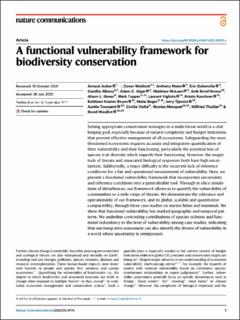| dc.contributor.author | Auber, Arnaud | |
| dc.contributor.author | Waldock, Conor | |
| dc.contributor.author | Maire, Anthony | |
| dc.contributor.author | Goberville, Eric | |
| dc.contributor.author | Albouy, Camille | |
| dc.contributor.author | Algar, Adam C. | |
| dc.contributor.author | McLean, Matthew | |
| dc.contributor.author | Brind'Amour, Anik | |
| dc.contributor.author | Green, Alison L. | |
| dc.contributor.author | Tupper, Mark | |
| dc.contributor.author | Vigliola, Laurent | |
| dc.contributor.author | Kaschner, Kristin | |
| dc.contributor.author | Kesner-Reyes, Kathleen | |
| dc.contributor.author | Beger, Maria | |
| dc.contributor.author | Tjiputra, Jerry | |
| dc.contributor.author | Toussaint, Aurèle | |
| dc.contributor.author | Violle, Cyrille | |
| dc.contributor.author | Mouquet, Nicolas | |
| dc.contributor.author | Thuiller, Wilfried | |
| dc.contributor.author | Mouillot, David | |
| dc.date.accessioned | 2023-01-16T08:07:09Z | |
| dc.date.available | 2023-01-16T08:07:09Z | |
| dc.date.created | 2022-09-16T14:00:29Z | |
| dc.date.issued | 2022 | |
| dc.identifier.citation | Nature Communications. 2022, 13 (1), 4774-?. | en_US |
| dc.identifier.issn | 2041-1723 | |
| dc.identifier.uri | https://hdl.handle.net/11250/3043559 | |
| dc.description.abstract | Setting appropriate conservation strategies in a multi-threat world is a challenging goal, especially because of natural complexity and budget limitations that prevent effective management of all ecosystems. Safeguarding the most threatened ecosystems requires accurate and integrative quantification of their vulnerability and their functioning, particularly the potential loss of species trait diversity which imperils their functioning. However, the magnitude of threats and associated biological responses both have high uncertainties. Additionally, a major difficulty is the recurrent lack of reference conditions for a fair and operational measurement of vulnerability. Here, we present a functional vulnerability framework that incorporates uncertainty and reference conditions into a generalizable tool. Through in silico simulations of disturbances, our framework allows us to quantify the vulnerability of communities to a wide range of threats. We demonstrate the relevance and operationality of our framework, and its global, scalable and quantitative comparability, through three case studies on marine fishes and mammals. We show that functional vulnerability has marked geographic and temporal patterns. We underline contrasting contributions of species richness and functional redundancy to the level of vulnerability among case studies, indicating that our integrative assessment can also identify the drivers of vulnerability in a world where uncertainty is omnipresent. | en_US |
| dc.language.iso | eng | en_US |
| dc.rights | Navngivelse 4.0 Internasjonal | * |
| dc.rights.uri | http://creativecommons.org/licenses/by/4.0/deed.no | * |
| dc.title | A functional vulnerability framework for biodiversity conservation | en_US |
| dc.title.alternative | A functional vulnerability framework for biodiversity conservation | en_US |
| dc.type | Peer reviewed | en_US |
| dc.type | Journal article | en_US |
| dc.rights.holder | © The Author(s) 2022 | en_US |
| dc.description.version | publishedVersion | en_US |
| cristin.ispublished | true | |
| cristin.fulltext | original | |
| cristin.qualitycode | 2 | |
| dc.identifier.doi | 10.1038/s41467-022-32331-y | |
| dc.identifier.cristin | 2052532 | |
| dc.source.journal | Nature Communications | en_US |
| dc.source.volume | 13 | en_US |
| dc.source.issue | 1 | en_US |
| dc.source.pagenumber | 4774-? | en_US |
| dc.relation.project | Norges forskningsråd: 295340 | en_US |
| dc.relation.project | Sigma2: NS1002K | en_US |
| dc.relation.project | Sigma2: NN1002K | en_US |

